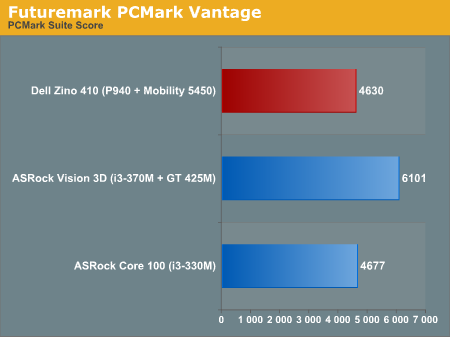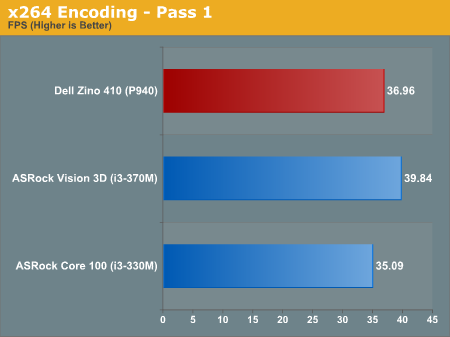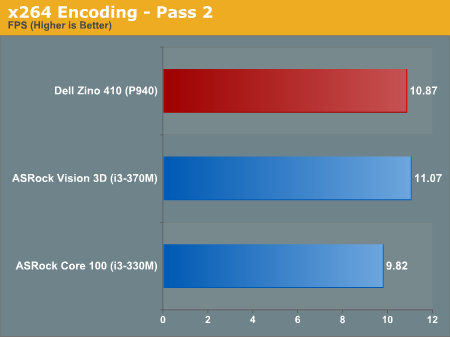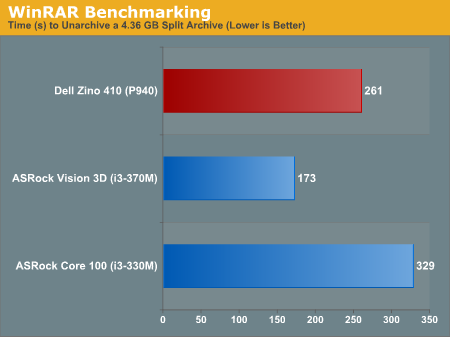Dell Zino HD 410 HTPC Review
by Ganesh T S on February 19, 2011 7:08 AM EST- Posted in
- HTPC
- Dell
- AMD
- Media Streamer
- ATI
The Zino 410 is basically a notebook solution at its core. It wouldn't make sense to compare it with full blown Clarkdale HTPCs (or for that matter, any system with a power consumption of more than 100W).
In the comparative benchmarks provided in the rest of this review, we will provide the scores obtained by the Zino 410 and other notebook / similar SFF HTPC solutions.
Windows Experience Index
This metric is often considered meaningless, but we feel it serves as an indicator of what could be the bottleneck in a system for pre-built HTPCs. Unsurprisingly, the weak 5450 emerges as the culprit for the 4.9 index scored by the Zino 410.
The other components, including the processor, memory and the hard disk check out well.
Miscellaneous Performance Metrics
The graphs below give an idea of where the Zino 410 HD HTPC stands with respect to performance when compared with other SFF HTPCs in the same range. PCMark Vantage's PCMark score gives a general idea of the system's capability.

In addition to that, a couple of common HTPC workloads are also benchmarked. We have some data on the x264 encoding performance using the Phenom CPU.


An estimate of how well WinRAR performs, particularly with respect to processing split archives, wraps up this section. To evaluate this, we take a 4.36 GB MKV file, compress it in the 'Best' compression mode into a split archive (97.1 MB each), which results in 44 files on the hard disk. The time taken to decompress this split archive is then recorded. The performance in this benchmark is heavily influenced by the hard disk in the system.

In the next section, we will take a look at the discrete Mobility 5450 GPU in more detail.











69 Comments
View All Comments
silverblue - Saturday, February 19, 2011 - link
...would having two differently-sized SO-DIMMs have on system performance?I'd be tempted to take replace that 4GB module with a 2GB one just to see what happens. 6GB of RAM just doesn't compute. :)
We seem to be getting a decent number of Dell-AMD systems lately... I only hope they take up Brazos with the same level of enthusiasm, because even if it did result in a small drop in performance, this review would've been largely the same in terms of gaming and video playback/quality, albeit with a much smaller footprint. Also, in that scenario, dual channel wouldn't matter as Fusion doesn't support it.
fabarati - Saturday, February 19, 2011 - link
If AMD has anything like Intels asynchronous dual channel, the first 4 GB will perform like dual channel, whilst the remaining 2 GB will perform like single channel.Taft12 - Saturday, February 19, 2011 - link
Dual-channel memory was a scam from the beginning that has somehow survived to this day to make PC buyers think they needed to buy more memory than needed.Have you seen the benchmarks? ~1-2% benefit AT MOST for anything that's not a synthetic memory bandwidth test, regardless of platform.
http://www.tomshardware.com/reviews/PARALLEL-PROCE...
fabarati - Saturday, February 19, 2011 - link
Didn't it help back in the P4 and/or P-M days? And how did it do in early Athlon 64 days?But yeah, Core Duo and newer doesn't really benefit from Dual channel, one
silverblue - Saturday, February 19, 2011 - link
Theoretically, dual channel would help APUs as they're bandwidth-limited.I suppose you're right about standard usage though, even raising memory clocks doesn't make for a sizeable performance advantage.
asmoma - Saturday, February 19, 2011 - link
Starcraft 2 is not a synthetic memory test, and it does benefit from going from 2 to three channels, just read some performance reviews of Starcraft 2.DanNeely - Saturday, February 19, 2011 - link
The einstien@home applications benefitted from a 3rd channel on i7 quad cores; and the 2nd channel on C2 quads as well; high performance server farms/clusters/super computers are a significant segment of the market. On the i7-quad, E@H had a 66% speedup from the 2nd channel, and a 5% gain from the 3rd. Sandybridge gave a similar speedup from the 2nd channel. I can't find the thread with the C2Quad results, but IIRC they were a 10-25% speedup.http://einstein.phys.uwm.edu/forum_thread.php?id=8...
I don't have benchmarks handy, but I suspect a heavily loaded DB server would also benefit from the extra memory bandwidth because the queries would result in a psudorandom memory access pattern that would limit the ability of the cache controller to prefetch most of the data being requested.
jeremyshaw - Friday, March 4, 2011 - link
that actually had to do with uncore clocks, not memory channels.vailr - Saturday, February 19, 2011 - link
How would a Mac Mini compare?Could a Mac Mini be retrofitted with a Blu-Ray drive (since Blu-Ray is available factory installed) and then run as a Windows HTPC?
tipoo - Saturday, February 19, 2011 - link
Why on earth would you buy a Mini to run as a Windows HTPC? You'd pay more for less performance.